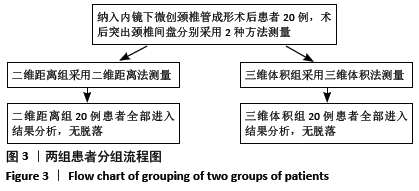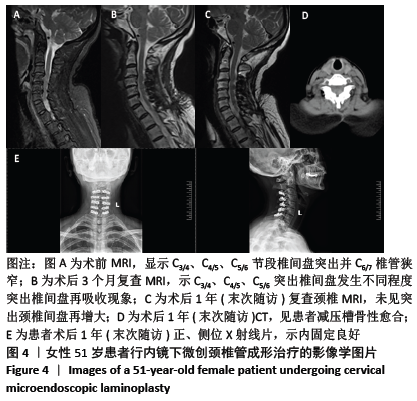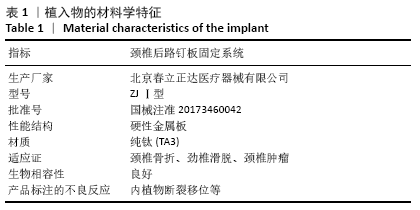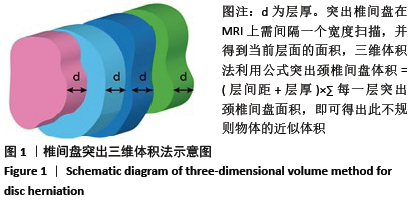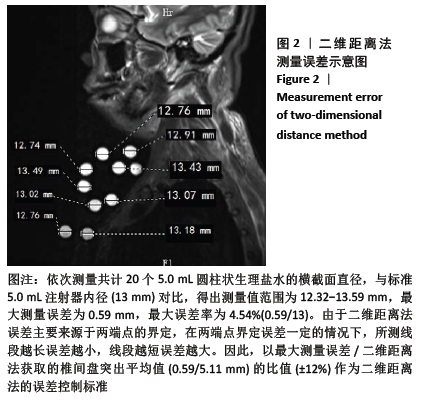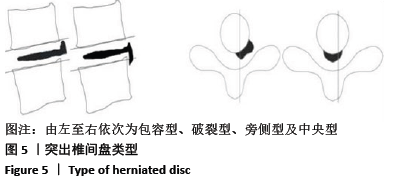中国组织工程研究 ›› 2021, Vol. 25 ›› Issue (21): 3390-3394.doi: 10.3969/j.issn.2095-4344.3858
• 骨与关节图像与影像 bone and joint imaging • 上一篇 下一篇
二维距离法和三维体积法对内镜下微创颈椎管成形后突出椎间盘再吸收的定量测量
吴彦禹,张春霖,邵成龙,严 旭,刘小康,王永魁,李东哲
- 郑州大学第一附属医院骨科,河南省郑州市 450000
Quantitative measurement of resorption of cervical herniated disc after cervical microendoscopic laminoplasty by two-dimensional distance method and three-dimensional volume method
Wu Yanyu, Zhang Chunlin, Shao Chenglong, Yan Xu, Liu Xiaokang, Wang Yongkui, Li Dongzhe
- Department of Orthopedics, First Affiliated Hospital of Zhengzhou University, Zhengzhou 450000, Henan Province, China
摘要:
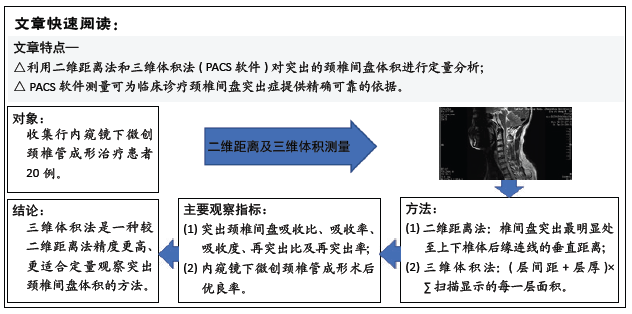
文题释义:
二维距离法:选取颈椎MRI矢状面椎间盘突出最明显层面,运用PACS系统测量技术从上下椎体后缘连线至椎间盘突出最明显处的垂直距离即为突出椎间盘的大小。
三维体积法:即应用PACS软件在MRI矢状位T2图像上,以上位椎体后下缘及下位椎体后上缘连线为内边界,突出物边缘作为外边界,得到当前层面突出椎间盘的面积,逐一测量每个层面的面积,利用以下公式计算突出颈椎间盘体积:突出颈椎间盘体积=(层间距+层厚)×∑每一层突出颈椎间盘面积。
突出椎间盘再吸收:指椎间盘突出后再次回缩吸收的现象,即resorption of herniated nucleus pulposus(RHNP)。
背景:文献报道内镜下微创颈椎管成形后出现不同程度的突出椎间盘再吸收现象,但目前尚未有统一的突出颈椎间盘测量方法。
目的:运用二维距离法和三维体积法分别测量内镜下微创颈椎管成形后突出椎间盘体积,并对比观察其突出椎间盘再吸收现象,选出更准确可靠的测量方法。
方法:回顾性分析郑州大学第一附属医院骨科2013年6月至2019年11月行内镜下微创颈椎管成形治疗的患者20例,其中男11例,女9例;年龄31-63岁,平均51岁;病程1-11个月,平均4个月。分别应用二维距离法和三维体积法测量突出颈椎间盘的突出程度,采用吸收比、吸收率、吸收度、再突出比及再突出率等指标评估测量结果。
结果与结论:①患者随访时间为6-34个月,20例病例共67个突出椎间盘,二维距离组中有56个突出椎间盘术后发生突出椎间盘再吸收,三维体积组有61个突出椎间盘术后发生突出椎间盘再吸收,二者吸收比分别为84%和91%,差异无显著性意义(P > 0.05);二维距离组和三维体积组测算吸收度分别为12.30%-71.24%和7.71%-87.80%;②二维距离组及三维体积组少量吸收比、中量吸收比、大量吸收比分别为49%(33/67)、34%(23/67)、0(0/67)和36%(24/67)、49%(33/67)、6%(4/67),两组各吸收度之间差异有显著性意义(P < 0.05);③二维距离组平均吸收率为31%,三维体积组平均吸收率为42%,二者差异有显著性意义(P < 0.05);④二维距离组及三维体积组再突出比分别为1.49%(1/67)和0,二维距离组该椎间盘再突出率为12.18%;⑤内镜下微创颈椎管成形患者术后优良率为85%(17/20),无一例加重或死亡;⑥提示三维体积法是一种较二维距离法精度更高、更适合定量观察突出颈椎间盘体积的方法,可为脊髓型颈椎病诊疗提供可靠依据。
https://orcid.org/0000-0002-6160-3118 (吴彦禹)
中国组织工程研究杂志出版内容重点:人工关节;骨植入物;脊柱;骨折;内固定;数字化骨科;组织工程
中图分类号:
